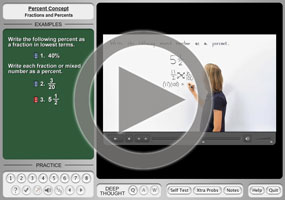Tables of Common Fractions and Their Decimal and Percentage Equivalents
Percent to DecimalPercent to FractionDecimal to FractionDecimal to PercentFraction to DecimalFraction to Percent
Purplemath
In the tables below, I have listed fractions with denominators between 2 and 10 (plus some elevenths and twelfths). Also, I have listed fractions only in their lowest denominators.
For instance, I don't list because it's equal to , which is covered in the "thirds" section of the tables.
Content Continues Below
Don't feel like you're required to memorize these fractions and their equivalents — you don't — but you should at least be familiar with the nice neat decimal equivalents, such as for the eighths and fourths, and the easy repeating decimals, like for the thirds and ninths.
Table of Common Fractions and Their Percentage Equivalents
Curious note: The elevenths convert to percentage form in terms of 9s. To find the whole-number part of the percentage, multiply the numerator of the original fractional form by 9, and affix the original fraction and then the % sign.
Content Continues Below
Table of Common Fractions and Their Decimal Equivalents or Approximations
Another curious note: Check out the decimal expansions for the sevenths. They all contain the exact same sequence of digits: 5, 7, 14, and 28. After the 5, we get the first four multiples of 7. The only difference, in the various expansions, is where in the pattern the expansion starts — which is sometimes in the middle of one of the numbers in the sequence! Weird, huh?
And, yes, the elevenths, all the way through to , are repeated multiples of 9: 0909, 1818, 2727, on up to 9090.
URL: https://www.purplemath.com/modules/percents4.htm
Select a Course Below
Standardized Test Prep
Homeschool Math
© 2024 Purplemath, Inc. All right reserved. Web Design by ![]()



